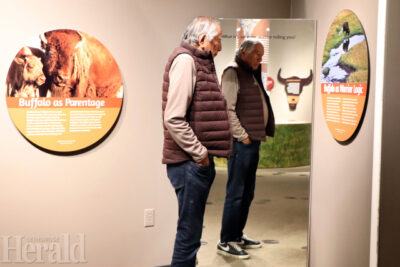Buffalo Treaty exhibit on display at Galt Museum
By Steffanie Costigan - Lethbridge Herald Local Journalism Initiative Reporter on April 5, 2024.
 Herald photo by Steffanie Costigan
Leroy Little Bear, who served as a member of the International Buffalo Relations Institute Team, looks at part of the Buffalo Treaty exhibit currently on display at the Galt Museum.
Herald photo by Steffanie Costigan
Leroy Little Bear, who served as a member of the International Buffalo Relations Institute Team, looks at part of the Buffalo Treaty exhibit currently on display at the Galt Museum.In honour of the 10-year anniversary of the Buffalo Treaty the exhibition of the Buffalo Treaty: Keystone to Wellness will be open to the public from until Sept. 30th.
“It’s important for people to recognize and remember Mayor Hyggen signed the Buffalo Treaty as a supporter back in 2023. So, every person who lives within the city limits has a responsibility and an accountability to be accountable to that signing,” said Indigenous curator of the Galt Museum and Archives Camina Weasel Moccasin on Thursday.
Weasel Moccasin shared her partnership with the International Buffalo Relations Institute in the development of the Buffalo Treaty exhibit.
“I worked with the International Buffalo Relations Institute to develop the content for the exhibit. Their sole purpose is to promote and implement the Buffalo Treaty,” she said.
Julian SpearChief-Morris, general counsel and acting executive director of the International Buffalo Relations Institute, voiced the importance of spreading awareness of buffalo consciousness.
“In our organization, we talk a lot about spreading buffalo consciousness, as we call it, spreading awareness about the significance of buffalo to Indigenous communities and non-Indigenous communities alike. Spreading awareness about ongoing buffalo repatriation efforts.
“And I think this is just such an awesome example of one of those great efforts to spread awareness about the Buffalo Treaty, about buffalo repatriation, and about the positive benefits of bringing battle buffalo back onto the landscape,” said SpearChief-Morris.
Vice-provost, Iniskim Indigenous Relations at University of Lethbridge Leroy Little Bear recalls the eight Indigenous tribes that originally signed the Buffalo Treaty.
“My feelings coming into this exhibit, is that it really captures all the happenings revolving around the buffalo since the Buffalo Treaty in 2014. So, the treaty was signed by four American tribes and four Canadian ones were the original signatories,” said Little Bear.
The Indigenous tribes which signed the Buffalo Treaty include the Blackfeet Nation, Blood Tribe, Siksika Nation, Piikani Nation, the Assinboine and Gros Ventre Tribes of Fort Belknap Indian Reservation, the Assinboine and Sioux Tribes of Fort Peck Indian Reservation, the Salish and Kootenai Tribes of the Confederated Salish and Kootenai Indian Reservation, and the Tsuu T’ina Nation along with Nakoda Nation.
Weasel Moccasin described how the buffalo benefits everyone.
“Buffalo is for everyone. Everybody can find a connection with buffalo in some way. The way that we have the exhibit setup right now is really drawing attention to the ways that the buffalo treaty can assist with holistic wellness.
“We have focus on the spiritual, the mental, the physical, and the emotional. And looking at how just having buffalo, or connection to Buffalo can really impact those areas of a person’s life,” she said.
SpearChief-Morris voiced the impact of the loss of the buffalo had on the Indigenous community and culture.
“So many of our songs, our ways, our stories, our practices, our history is built on the buffalo. And you can imagine the impact that not having buffalo around had on those practices, those ways of culture.
“Having buffalo back again has been just such a positive thing for our community. And for a lot of communities like ours, again, Indigenous and non-Indigenous alike. And that is a big reason why the Buffalo Treaty was signed in the first place. Why our organization exists to bring back buffalo.”
Little Bear also voiced the impact colonization had on the buffalo.
“So much Indigenous people have, have had this embodiment of the Buffalo and along with that, of course, the environment…
“But because of colonization piecemealing out the land and into little plots of land and separating into ownership by government, by individuals and so on, that kind of prevented those practices and so much,” said Little Bear.
SpearChief-Morris said he hopes to spread awareness of buffalo being back on the lands.
“There are significant efforts being made to bring buffalo back onto the landscape. And I think also just to normalize the fact that buffalo are back on the landscape…
“This is historic buffalo territory. And I think there’s a growing awareness about both the significant impact that buffalo had on the landscape, can continue to have in the landscape, and the negative consequences that have come about because buffalo had been removed from the landscape for so long.”
Little Bear expressed the feeling of renewal Indigenous people will experience with the Buffalo Treaty exhibit.
“When people come in see an exhibit like this, it brings back all that memory. That renewal begins to occur. And so much, even the language, the songs and the ceremonies that go with the buffalo, all come back to you. So, it really is a renewal for all the people,” he said.
25-24





[…] Source link […]